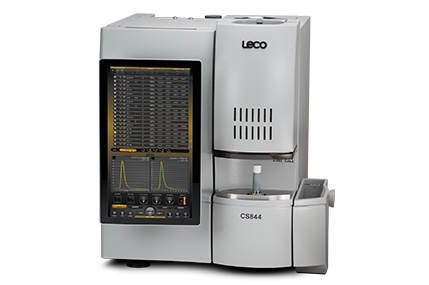844 Series Combustion
Carbon and Sulfur Analysis by Combustion
Easily analyze your wide-range carbon and sulfur content with our CS844 for the determination of carbon and sulfur in primary steels, ores, finished metals, ceramics, and other inorganic materials using the combustion technique. State-of-the-art hardware and our exclusive Cornerstone® touch-screen software platform provide your laboratory with increased usability and a lower cost-per-analysis.
- Maximize laboratory productivity with automation
- 10- and 60-position shuttle loaders or integrated robotic process loaders available.
- High-efficiency autocleaner/vacuum system keeps maintenance to a minimum
- Automatic combustion tube service and exchange system
- Ergonomic, operator-centered design with a boom-mounted touch-screen interface
- Improved IR cell design provides dual-range detection and improved lifetime and stability
- High-efficiency furnace with low-maintenance design reduces the need for additional accelerant and cleaning
Applications
The 844 series is ideal for the following applications: primary steels, ores, finished metals, ceramics, alloys, and other inorganic materials.
The CS844 Carbon/Sulfur system is designed for wide-range measurement of carbon and sulfur content of metals, ores, ceramics, and other inorganic materials. The instrument features custom software designed specifically for touch operation.
A pre-weighed sample of approximately 1 gram is combusted in a stream of purified oxygen using RF induction to heat the sample. Carbon and sulfur present in the sample are oxidized to carbon dioxide (CO2) and sulfur dioxide (SO2), and swept by the oxygen carrier through a heated dust filter, a drying reagent, and then through two non-dispersive infrared (NDIR) cells, where sulfur is detected as SO2. The gas flow continues past a heated catalyst, where carbon monoxide (CO) is converted to CO2 and where SO2 is converted to sulfur trioxide (SO3), which is subsequently removed by a filter. Carbon is then detected as CO2 by a second pair of NDIR cells. A pressure controller is used to maintain constant pressure in the NDIR cells so as to reduce interference from natural variations in atmospheric pressure. The final component in the flow stream is an electronic flow sensor, which is used for diagnostic purposes to monitor the carrier flow.
Non-dispersive infrared cells are based on the principle that CO2 and SO2 absorb infrared (IR) energy at unique wavelengths within the IR spectrum. Incident IR energy at these wavelengths is absorbed as the gases pass through IR absorption cells. Since absorption is dependent upon the path length, short and long path-length IR cells are provided for measurement of high and low range signals. The software automatically selects which cell to use for optimum measurement. The concentration of unknown samples is determined relative to calibration standards. To reduce interferences from instrument drift, reference measurements of pure carrier gas are made prior to each analysis.
844 Series Details

- Models
-
CS844 Carbon/Sulfur
-
C844 Carbon
-
S844 Sulfur
- CS844ES Enhanced Sulfur, Carbon
- S844ES Enhanced Sulfur
-
- Options
-
Shuttle10 Autoloader
-
Shuttle60 Autoloader
- Tube Furnaces
-
- Featured application
Carbon/Sulfur in Low Carbon Ferroalloys - Product literature
844 Series
844 with S832 Add-On - Consumables

